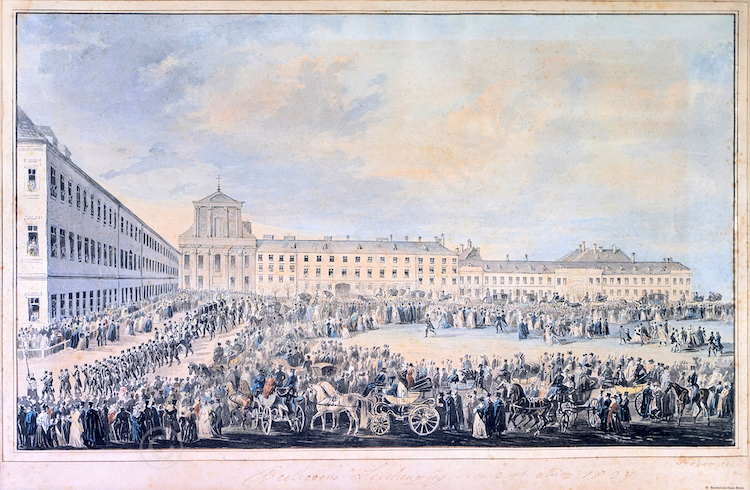The World of Beethoven’s Music
Before we continue, we should step back and remember that drastic changes were passing over European society as the nineteenth century was beginning. These changes affected artistic and intellectual life as radically, if not quite as rapidly, as they affected political life.
The French Revolution was the outward sign that the older civilization of the eighteenth century was breaking up. In the first years of the nineteenth century, the whole of Europe was in turmoil.
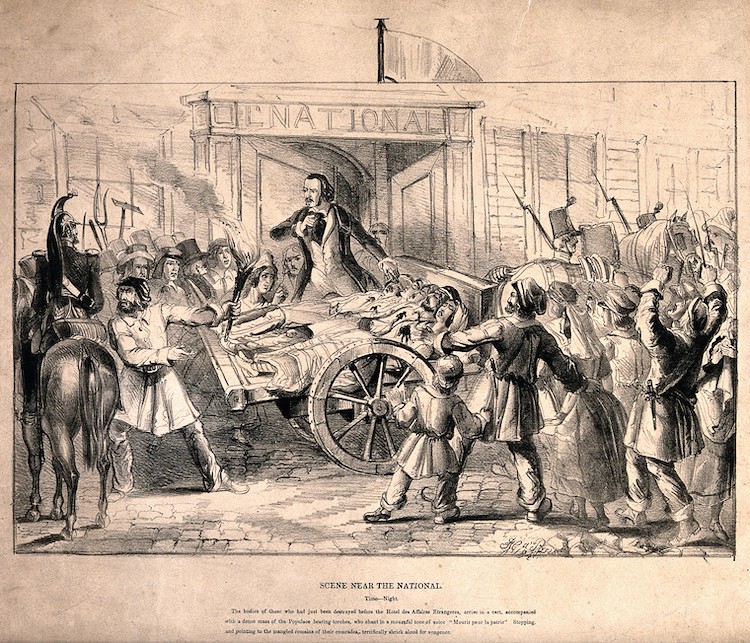
It may seem that wars and material catastrophes do not check artistic progress. Yet the intellectual ideas of which wars are a symptom affect the course of art powerfully. Twice during the most productive part of Beethoven’s career, Vienna was occupied by the armies of Napoleon, but his work went steadily forward.
Nevertheless, the idea which brought those armies into existence—since it permeated the whole of European life—was at the very root of Beethoven’s music. The French revolutionists’ cry of ‘Liberty, Equality, and Fraternity’ was the party cry of the moment—although it ultimately ended with the opposite of what it preached.
The spirit of the age advocated for the assertion of independent thought and action. This spirit was stirring in the English and German nations, both of which were strongly opposed to its most violent political developments in France.
But the independent spirit was what gave birth to the inventive genius of the nineteenth century. It is this spirit that we hear in the music of Beethoven.
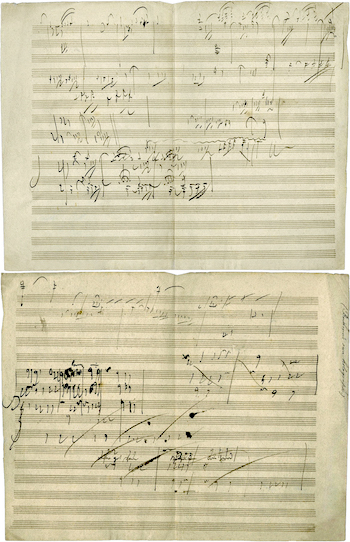
Here we may find the strongest reason for Beethoven’s slow working and his comparatively small output. Haydn and Mozart could turn out symphonies and quartets by the dozen because they accepted certain principles of order without question. Everything that was beautiful was worth expressing and could be expressed by certain means which they and their contemporaries had learned to use readily.
With Beethoven every work must be a matter of strong personal conviction; it must be thought out afresh from the beginning. Since nothing was fixed once and for all, there were no rules to be taken for granted. When he looked back on his early works and found how much he had taken for granted, the discovery disgusted him and caused outbursts of anger against himself.
He had the conviction that he must solve each problem in its own way. Things which he had once accepted unhesitatingly gave way before his independent vision. First, he questioned the mannerisms of melody and ornament which he had inherited from Haydn and Mozart. Next, he felt that even his own ideas as he first put them on paper did not truly represent his feelings.
He therefore adopted the plan of jotting down musical ideas as they came, merely catching a glimpse of his thought as it passed. He then examined them, discovered what part represented his thought, gradually formed melodies, extended them, and composed them into their final shape.
Listen to 1st Mvt: Adagio – Presto from Violin Sonata No. 9 ‘Kreutzer’ Op. 47 (3 min)
Performed by two wonderful musicians: American violinist Joshua Bell and Chinese pianist Yuja Wang. Listen to at least the first 3 minutes.
Timing: Mvt 1. Adagio sostenuto–Presto – 0:33 | 2. Andante con Variazioni – 11:53 | 3. Finale. Presto – 26:05
These thoughts and themes fill his sketch-books, large volumes of rough music paper which he constantly carried with him, many of which have been preserved. In them we can see many of his greatest works gradually taking form into the works we know today.
It was Beethoven’s unique vision combined with this process that resulted in such incredibly powerful music. In his best works, his strong and independent personality seems to leap out to the listener in an incredibly personal way.
Beethoven’s whole attitude toward the subject of musical form can be understood in the light of this new spirit, which made him bring everything to the test of experience. The great majority of his works were composed within the short period of twelve years; that is to say, from the year 1800 when the First Symphony appeared to the year 1812 when he produced the Seventh and Eighth Symphonies.
These works are a logical development out of the sonata form which Haydn and Mozart had initiated and applied with various modifications. They are in direct succession; there is no break.
But that does not imply that Beethoven took the form for granted all this time. On the contrary, the better one knows Beethoven’s work, the more one realizes that he constantly considered it afresh to see whether it was fit to bear the weight of what he wanted to express. He only accepted the form because he found it fitted. Where he was not satisfied, he altered his design.
Middle Period Works
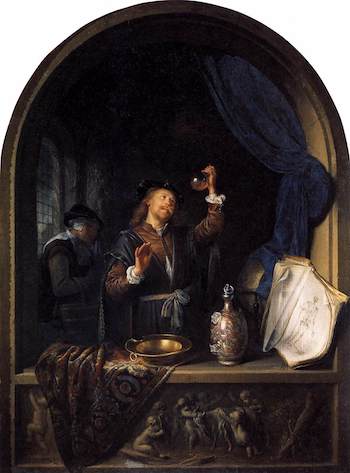
In 1801, Beethoven wrote to a friend “Know then that my noblest faculty, my hearing, has been sadly deteriorated. When you were still with me I had intimations of this, but said nothing about them. Now it has been growing steadily worse, and whether it can be cured remains to be seen, the trouble probably coming from the condition of my abdomen. What a sorrowful life I must now live, avoiding all that is dear and precious to me, and, too, among such miserable and egotistical people. Sorrowful resignation—in this must I find refuge.”
His deafness gradually became worse and, since one doctor after another failed to find a remedy, Beethoven’s depression of spirit increased. In 1802, he spent the summer in the village of Heilengestadt, where he wrote a gloomy suicidal Testament—a document of utter despair and futility, caused by the oncoming silence. By the close of 1802, his illness had become so acute that he was compelled to give up all of his piano performances in public and much of his conducting. Instead, he devoted himself almost exclusively to composition.
At the same time, he segregated himself from all society, and prepared to live in solitude. Deafness marked the prelude of the second creative period in Beethoven’s life—a period that produced some of his most famous masterpieces. “I am now making a fresh start,” he wrote at this time.
Between 1803 and 1804 he produced the Piano concerto No. 3 in C minor, the Kreutzer sonata for violin and piano, the Waldstein and Appassionata piano sonatas, and Symphony No. 3, the ‘Eroica’ symphony.
Beethoven had originally intended calling Symphony No. 3 the “Buonaparte symphony.” This was before Napolean revealed his imperial intentions. When Beethoven heard that Napoleon had declared himself Emperor of France, he broke out angrily saying, “then he is nothing but an ordinary man. Now he’ll trample on all the rights of men to serve his own ambition, he will put himself higher than all others, and turn tyrant!” Following this cry, he tore the dedicatory page of the symphony to shreds, and entitled the work merely the “Eroica” (Heroic).
Listen to the 1st Movement: Allegro from Symphony No. 3, ‘Eroica’ (7 min)
Watch at least seven minutes of the first movement (actually 18 minutes). Performed by the Symphony Orchestra of Bayerischen Rundfunks conducted by Mariss Jansons
The flood of masterpieces had begun, and until 1812 it continued virtually without intermission. Beethoven’s only opera, Fidelio, came in 1805. Between 1806 and 1808, he composed his Fourth, Fifth, and Sixth symphonies. This was also the period of his Violin Concerto.
Beethoven’s Violin Concerto
Beethoven composed but one concerto for violin and orchestra (Op. 61). It is as if he realized that he had exhausted the artistic possibilities of the form. Certainly it is an epic work, dwarfing all earlier violin concertos.
A symphonic orchestral introduction opens with four drum beats (it is said that this subject for tympani came to Beethoven upon hearing someone knock at the door), which point to the first theme voiced by the reeds. The second subject, also spoken by the reeds, follows a brief development. These two subjects are used with an amazing richness of imagination. It is a long development, symphonic in its proportions and large in its scope and aspirations, in which the melodic and polyphonic invention seems inexhaustible.
In the second movement, a Larghetto (a slow tempo slightly faster than largo) brings a brief interval of repose: the orchestra sings a melody of quiet and tender beauty which the violin embellishes with picturesque figurations. A brief cadenza then leads directly to a Rondo, the principal theme of which has the character of a peasant dance. In contrast, a sentimental melody is played by the violin.
Composed in 1806, the concerto was introduced by Franz Clement at the Theater-an-der-Wien on December 23 of that year. The violinist was compelled to read the work at sight, because Beethoven retained the manuscript until the last possible moment for revisions.
Listen to the 2nd Movement: Larghetto of the Violin Concerto (9 min)
Begin watching at 22:36. Performed by the renowned Ukrainian violinist Nathan Milstein. He gives a delicate and lyrical performance on his 1716 “Goldman” Stradivarius violin. It is truly magnificent. Sir Adrian Boult conducts the London Philharmonic. (You may need to turn your volume up because of the recording level.)
Timing: 1. Allegro ma non troppo – 0:00 | 2. Larghetto – 22:36 | 3. Rondo. Allegro – 31:43
At the same time came his Piano Concerto No. 4 and No. 5, the three ‘Razumovsky’ string quartets, and the magnificent overtures to the plays Egmont and Coriolanus.
These two overtures are self-contained music dramas, with an unerring sense for good theater shown in its conflicts and climaxes, and with a fine feeling for characterization.
The Egmont Overture, Op. 84, composed in 1809-10, is one of several pieces that Beethoven wrote as incidental music for Goethe’s play. A hero in the struggle for the liberation of the Netherlands from Spain, the Count of Egmont was executed as the result of an infamous conspiracy. The heroism of the man, the strength and nobility of his character, speak out unmistakably in the majestic opening for strings. The Egmont Overture, together with other incidental pieces (including four entr’actes and two songs), was first performed at the presentation of the Goethe play at the Burgtheater in Vienna on May 24, 1810.
Listen to the ‘Egmont’ Overture (9 min)
Conducted by the intense German conductor Herbert von Karajan and the Berlin Philharmonic. Karajan was known throughout his lifetime as a powerful interpreter of Beethoven. (You can advance to 0:30 seconds to avoid the credits.)
In 1812, Beethoven’s sublime output was climaxed by the creation of the Seventh and Eighth symphonies. The characteristic of Beethoven’s masterpieces of this period—a characteristic which sharply differentiated this music from all others—is the ‘poetic idea.’ In these works, it is not merely the sound patterns, the melody line, or the subtlety of rhythms or harmonies which intrigue us, but the expression of profound thoughts and poignant emotions. It is these characteristics that make Beethoven’s music so incredibly unique. They ushered in the Romantic period in music.
Beethoven’s Late Period
In the final years of Beethoven’s life, he was completely isolated from the outer world. This was the period in which he wrote his famous Ninth Symphony, his last sonatas and string quartets, and his profound Missa Solemnis (Solemn Mass).
With these works, Beethoven entered into the final period of his artistic development. It is often spoken of as a “metaphysical period” because he became more experimental than ever before. He composed his music with greater profundity of ideas and thought, but with extremely new ideas and approaches. Many musicians and friends who loved his former music found these new works difficult and strange. For many years they were the subject of great controversy.
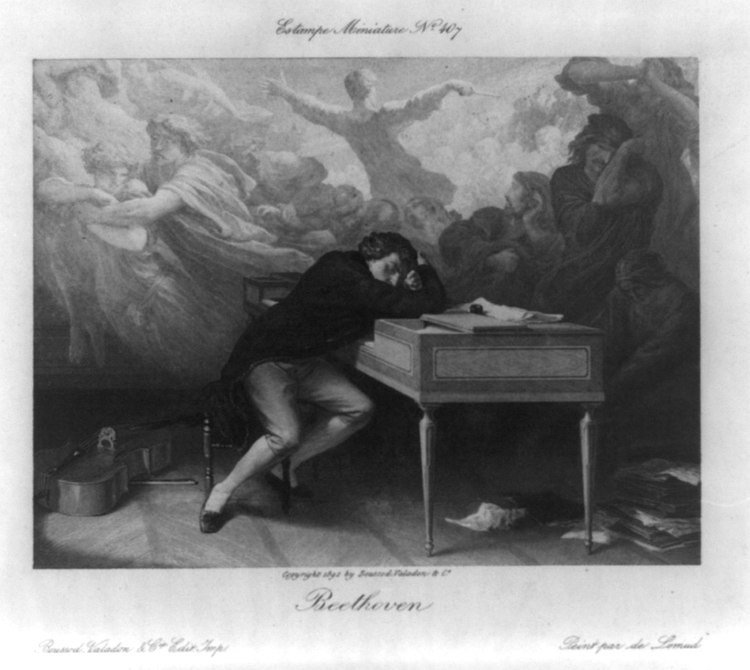
If you listen to any of these piano sonatas or string quartets, there seems to be a profound dissatisfaction with every established form and conventional ornament acceptable in the music of the eighteenth century. Beethoven seems to discard the charm of carefully balanced chords and harmonic effects. He often replaces them with notes of turbulent energy followed suddenly by serene calm. In his piano music, the musician’s hands are often spread to the two ends of the keyboard in order to make a gigantic sweep of melody over notes which have the least possible amount of resonance in combination.
Listen to the 1st Movement: Moderato cantabile molto espressivo from Piano Sonata No. 31 (6 min)
Performed here by the extremely eccentric but incredibly talented Austrian pianist Friedrich Gulda near the end of his life. This is taken from a 1993 concert in Japan. One of the wonderful things about this performance is his ability to maintain the voice of song in the music.
Some people blamed these unique sounds on Beethoven’s deafness, but he had been deaf long before this point. Instead, it is as if his deafness sealed him off from the outside world of sound so he could explore new musical ideas inside his own head. The results are considered by many to be some of Beethoven’s most transcendent music.
Apart from their actual style, there are various signs that the last quartets of Beethoven were closely bound up with the tragic experiences of his life. At the head of the Adagio of the quartet in A minor he wrote, “Sacred song of thanksgiving to the Deity of one restored to health.” This is succeeded by an Andante, above which he wrote, “Feeling new strength.”
Sir George Smart visited Beethoven in 1825 and happened to come in for the first private performance of this quartet. He refers to it in his diary. “Beethoven intended to allude to himself, I suppose, for he was very ill during the early part of this year.”
Listen to the 3rd Movement: Adagio from String Quartet No. 15 in A Minor, Op. 132 (3 min)
An emotionally moving performance from the Danish Quartet. It is heavenly music indeed. Listen to at least the first 3 minutes.
Final Days
During the final days of his life, Beethoven was in a good temper. He read Sir Walter Scott and Ovid, whom he enjoyed immensely, and was greatly pleased at the gifts which came to his sick-bed. These included a magnificent edition of Handel, a sum of five hundred dollars from the London Philharmonic Orchestra, and a case of Rhine wine from his publisher.
But Beethoven knew his end was near. On March 23 he signed his will, and the following day he submitted quietly to the Last Sacraments of the Catholic Church. On the 25th of March he slipped into unconsciousness.
The following day there was thunder and lightning in Vienna. Suddenly, at a peal of thunder, Beethoven lifted himself up in his bed, directed a defiant fist at the growling heavens, and then fell back. He was dead.
The funeral took place on the 29th. The schools of Vienna closed in Beethoven’s honor, and over 25,000 admirers came to pay their last respects to the greatest composer of the new century.
